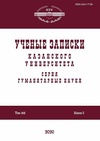Антропологический взгляд на эпидемии чумы в историческом прошлом
Anthropological view of plague epidemics in the historical past
Author(s): Timur Faritovich Khaydarov, D.A. DolbinSubject(s): Regional Geography, Health and medicine and law, 13th to 14th Centuries, 15th Century, 18th Century
Published by: Казанский (Приволжский) федеральный университет
Keywords: paleogenetics of Y. pestis; zero plague pandemic; “Justinian’s Plague”; “Black Death”; repeated plague outbreaks in 15th–18th centuries (second plague);
Summary/Abstract: At many times in their history, humans have faced major epidemics. The “Black Death”, which broke out in the middle of the 14th century, is believed to be the deadliest one. The total number of the deceased population and the scale in many ways had a dramatic impact on the course of subsequent historical events. Until recently, the myths dating back to the Middle Ages have prevailed in scientific circles. They have remained unrevised despite the latest achievements in the research on the plague bacterium Yersinia pestis, the history of climate and medicine, and the extensive published data, making it of an interest to both reconsider certain established dogmas and reconstruct the algorithm of the course of major plague epidemics from the historical past using the results of the available paleogenetic, epidemiological, and climatological studies. This triggered our discussion on the nonlinear nature of the course of plague pandemics. The analysis of the historical sources showed that the scale and speed of the spread of plague epidemics in new territories directly depended on the degree of inclusion of cities and regions of the Afro-Eurasian space in the economic system of the Great Silk Road, the proximity to various epidemic centers of plague. The decisive influence of the anthropogenic factor on the duration and main directions of the spread of plague epidemics was revealed. The multivariate onset and course of pandemic plague waves were recognized. Therefore, it is difficult to pinpoint the exact place where the spread of the plague epidemics ended or to identify their consequences.
Journal: Ученые записки Казанского университета. Серия Гуманитарные науки
- Issue Year: 163/2021
- Issue No: 6
- Page Range: 179-201
- Page Count: 23
- Language: Russian

